

|
|
|
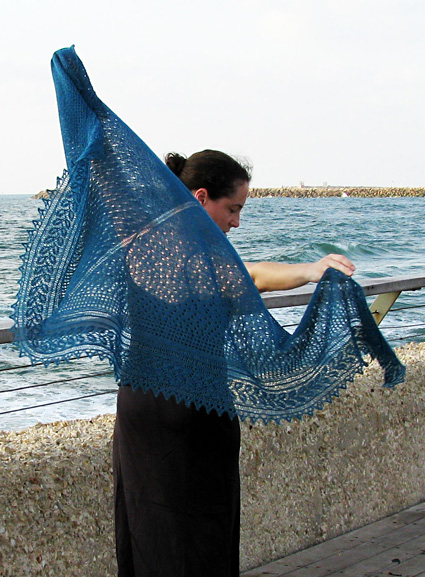
I love triangular shawls. I also love complicated lace. And I love simplicity. The last two don’t usually coordinate with each other, and that’s why I find it very hard to find a perfect shawl pattern for me. I wanted to create something that was both complicated-looking, but also very simple in terms of construction and pattern. Something that won’t need the knitter’s full attention and could easily be done in front of the TV, but will have a big “wow factor” when finished. This shawl is very simple and intuitive to make. You don’t need to follow the directions exactly to get similar results. The only thing that pushes it into the ‘piquant’ section is the knitted-on lace border. The shawl can be made smaller or bigger very easily without any calculations at all. When the body for the sample shawl was finished, I couldn’t
help but think that it looks like waves splashing on the deck
of the bay. I chose the Elm Leaf pattern for the edging because
it reminded me of seaweed. |
||
|
|

|
Tweet
|
|
SIZE |
|
|
FINISHED MEASUREMENTS |
|
MATERIALS Notions |
|
GAUGE |
| 27 sts/40 rows = 4 inches in stockinette stitch |
|
PATTERN NOTES |
|
Gauge is not critical for this project. Use the needle size which gives you the best looking results. This shawl requires a single skein (1375 yd) of laceweight yarn, and uses it almost entirely. If your gauge is a bit looser than specified or you’re not sure you’ll have enough yarn, be prepared to either break into a second skein, or make the shawl slightly smaller (directions for adjusting size follow). The Ocean Spray section is constructed of very simple repeats of yo/k2tog or ssk/yo with a constant number of k sts in between. It starts with 13 k sts between the yo/decrease pairs, the next section has 9 k sts in between and so on. That constant number gets smaller as the shawl grows bigger, until the last rows are ‘yo, k2tog’ repeated over and over again. That’s the reason the Ocean Spray section is not charted. It’s way too simple for a chart! The shawl can easily be made bigger or smaller. Just add or subtract rows from the Ocean Spray section (for example, instead of four eyelet rows in every section, make three). The border can be added to any size shawl with no calculations needed. Provisional Cast On Elm Leaf pattern: Row 1 [RS]: Sl1, K3, yo, k2tog, slm, k1, yo, k1, ssk,
p1, k2tog, k1, yo, p1, ssk, p1, k2tog, [yo, k1] twice, slm, k2,
yo, k2tog, yo, yo, k2. |
The chart for this pattern is very large and fits on a letter-sized page. Click here and print the resulting page. Note: Row 8: 1 st remains on needle after BO, before the k3 is worked. |
|
DIRECTIONS 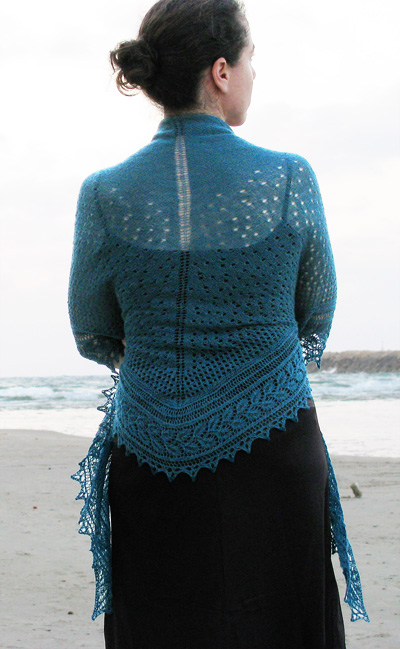
Using a provisional CO method, CO 3 sts. K 7 rows, do NOT turn at the end of the final row. Rotate work 90 degrees clockwise. Pick up and knit 3 sts, one in each garter ridge along the side of work. Unravel the scrap yarn at CO to reveal the live sts. Knit those 3 sts. 9 sts total. Set up row 1 [RS]: K3, yo, k1, yo, pm, k1 (center st),
yo, k1, yo, pm, k3. 4 sts increased, 13 sts total. Repeat Rows 1 and 2 49 times. 213 sts. Section 2 – Ocean
Spray: If you want a smaller shawl, no problem! Just knit fewer eyelet rows on every (or a few) of the sections. But take into account that your stitch count will be different than written on the next rows. Which is not a problem either, because it’s all random! Every other RS row is worked plain (rows 4, 8, 12, etc.). This is maintained throughout the pattern until the garter stripe. The garter edge with adjacent ‘yo’ and the center ‘yo, k1, yo’ are bolded to make reading easier. 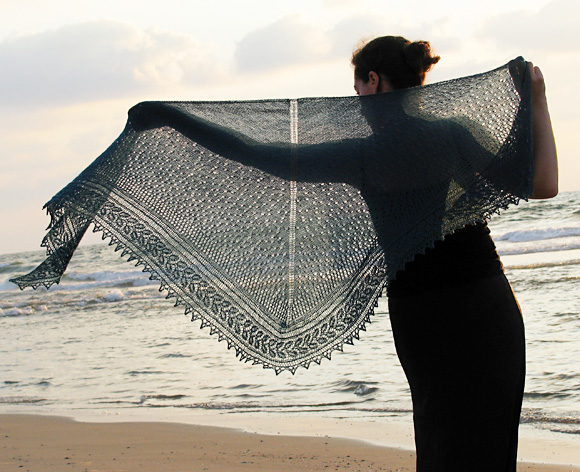
Row 1 and every following odd-numbered row [WS]: K3, p to last 3 sts, k3. Row 2: K3, yo, k3, [yo, k2tog, k13] to 12 sts from marker, yo, k2tog, k10, yo, slm, k1, yo, k10, [ssk, yo, k13] to 5 sts from marker, ssk, yo, k3, yo, k3. 221 sts. Row 4: K3, yo, k to marker, yo, slm, k1, yo, k marker, yo, k3. 225 sts. Row 6: K3, yo, k10, [yo, k2tog, k13] to 9 sts from marker, yo, k2tog, k7, yo, slm, k1, yo, k7, [ssk, yo, k13] to 12 sts from marker, ssk, yo, k10, yo, k3. 229 sts. Row 8 and every other RS row: Repeat row 4. Row 10: K3, yo, k2, [yo, k2tog, k13] to 6 sts from marker, yo, k2tog, k4, yo, slm, k1, yo, k4, [ssk, yo, k13] to 4 sts from marker, ssk, yo, k2, yo, k3. 237 sts. Row 14: K3, yo, k13, [yo, k2tog, k13] to 14 sts from marker, yo, k2tog, k12, yo, slm, k1, yo, k12, [ssk, yo, k13] to marker, yo, k3. 245 sts. Row 18: K3, yo, k9, [yo, k2tog, k13] to 7 sts from marker, yo, k2tog, k5, yo, slm, k1, yo, k5, [ssk, yo, k13] to 11 sts from marker, ssk, yo, k9, yo, k3. 253 sts. 11-st Repeat Section: Row 26: K3, yo, k11, [yo, k2tog, k9] to 8 sts from marker, yo, k2tog, k6, yo, slm, k1, yo, k6, [ssk, yo, k9] to 2 sts from marker, k2, yo, k3. 269 sts. Row 30: K3, yo, k9, [yo, k2tog, k9] to 3 sts from marker, yo, k2tog, k1, yo, slm, k1, yo, k1, [ssk, yo, k9] to marker, yo, k3. 277 sts. Row 34: K3, yo, k6, [yo, k2tog, k9] to 10 sts from marker, yo, k2tog, k8, yo, slm, k1, yo, k8, [ssk, yo, k9] to 8 sts from marker, ssk, yo, k6, yo, k3. 285 sts. 10-st Repeat Section: Row 42: K3, yo, k1, [yo, k2tog, k8] to 4 sts from marker, yo, k2tog, k2, yo, slm, k1, yo, k2, [ssk, yo, k8] to 3 sts from marker, ssk, yo, k1, yo, k3. 301 sts. Row 46: K3, yo, k10, [yo, k2tog, k8] to 9 sts from marker, yo, k2tog, k7, yo, slm, k1, yo, k7, [ssk, yo, k8] to 2 sts from marker, k2, yo, k3. 309 sts. Row 50: K3, yo, k7, [yo, k2tog, k8] to 6 sts from marker, yo, k2tog, k4, yo, slm, k1, yo, k4, [ssk, yo, k8] to 9 sts from marker, ssk, yo, k7, yo, k3. 317 sts. 9-st Repeat Section: Row 58: K3, yo, k5, [yo, k2tog, k7] to 3 sts from marker, yo, k2tog, k1, yo, slm, k1, yo, k1, [ssk, yo, k7] to 7 sts from marker, ssk, yo, k5, yo, k3. 333 sts. Row 62: K3, yo, k3, [yo, k2tog, k7] to marker, yo, slm, k1, yo, k7, [ssk, yo, k7] to 5 sts from marker, ssk, yo, k3, yo, k3. 341 sts. 8-st Repeat Section: Row 70: K3, yo, k5, [yo, k2tog, k6] to marker, yo, slm, k1, yo, k6, [ssk, yo, k6] to 7 sts from marker, ssk, yo, k5, yo, k3. 357 sts. Row 74: K3, yo, k3, [yo, k2tog, k6] to 6 sts from marker, yo, k2tog, k4, yo, slm, k1, yo, k4, [ssk, yo, k6] to 5 sts from marker, ssk, yo, k3, yo, k3. 365 sts. 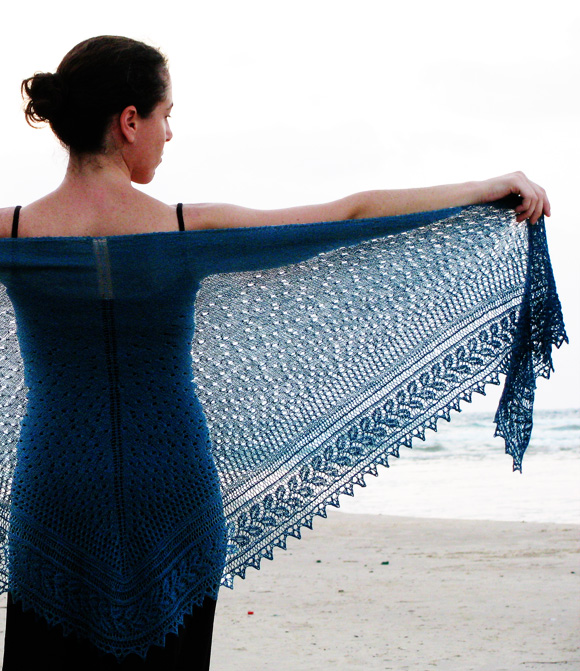
Row 78: K3, yo, k6, [yo, k2tog, k5] to marker, yo, slm, k1, yo, k5, [ssk, yo, k5] to 1 st from marker, k1, yo, k3. 373 sts. Row 82: K3, yo, k5, [yo, k2tog, k5] to 5 sts from marker, yo, k2tog, k3, yo, slm, k1, yo, k3, [ssk, yo, k5] to marker, yo, k3. 381 sts. Row 86: K3, yo, k4, [yo, k2tog, k5] to 3 sts from marker, k3, yo, slm, k1, yo, k8, [ssk, yo, k5] to 6 sts from marker, ssk, yo, k4, yo, k3. 389 sts. 6-st Repeat Section: Row 94: K3, yo, k4, [yo, k2tog, k4] to 1 st from marker, k1, yo, slm, k1, yo, k5, [ssk, yo, k4] to marker, yo, k3. 405 sts. Row 98: K3, yo, k3, [yo, k2tog, k4] to marker, yo, slm, k1, yo, k4, [ssk, yo, k4] to 5 sts from marker, ssk, yo, k3, yo, k3. 413 sts. 5-st Repeat Section: Row 106: K3, yo, k4, [yo, k2tog, k3] to marker, yo, slm, k1, yo, k3, [ssk, yo, k3] to 1 st from marker, k4, yo, k3. 429 sts. 4-st Repeat Section: Row 114: K3, yo, k3, [yo, k2tog, k2] to 2 sts from marker, k4, yo, slm, k1, yo, k4, [ssk, yo, k2] to 1 st from marker, k1, yo, k3. 445 sts. 3-st Repeat Section: 2-st Repeat Section: Row 126: K3, yo, k2, [yo, k2tog] to 1 st from marker, k1, yo, slm, k1, yo, k1, [ssk, yo] to 2 sts from marker, k2, yo, k3. 469 sts. Row 128: Repeat Row 4. Repeat Rows 122 to 126 once more, ending with row 126 (RS row). Do not work the next row. 485 sts. Garter stripe: 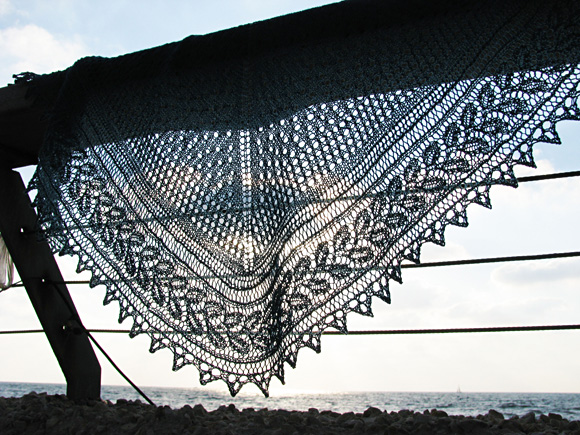
Note: The border is worked sideways. Each WS row of the border ends with a p2tog – one border stitch and one original body stitch. The border is worked until all the original body stitches are “eaten” by the p2tog decreases. Set up row 1: Using yarn of shawl and with RS facing,
CO 28 sts using the backward loop method. Turn work. With RS facing, begin working the Elm Leaf pattern (from written instructions or chart, as you prefer). Work pattern until there are two original body stitches left, ending on a WS (the number of repeats depend on the size of your shawl). And it doesn’t matter which row you finish on! Repeat Rows 1 and 2 above twice. No body sts left. BO all stiches. |
|
FINISHING |
| ABOUT THE DESIGNER |
|
|
|
Pattern & images © 2011 Galia Lael. Contact Galia |